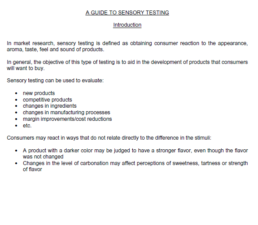A GUIDE TO SENSORY TESTING
Introduction
In market research, sensory testing is defined as obtaining consumer reaction to the appearance, aroma, taste, feel and sound of products.
In general, the objective of this type of testing is to aid in the development of products that consumers will want to buy.
Sensory testing can be used to evaluate:
- new products
- competitive products
- changes in ingredients
- changes in manufacturing processes
- margin improvements/cost reductions
- etc.
Consumers may react in ways that do not relate directly to the difference in the stimuli:
- A product with a darker color may be judged to have a stronger flavor, even though the flavor was not changed
- Changes in the level of carbonation may affect perceptions of sweetness, tartness or strength of flavor
SELECTING THE APPROPRIATE PRODUCT TEST
Your company has developed a new formulation for an existing product and market research has been requested. How do you decide which is the appropriate test and the correct sample composition to evaluate the reformulation? In order to design the appropriate test, there are a series of questions that need to be answered:
- Why was the new formulation developed?
-
- Is it a product improvement?
- Is a cost reduction/margin improvement?
- Is the change being made to attract non-users/less frequent users of the brand?
- Is an ingredient being changed because of lack of availability or to comply with governmental regulations (FDA, etc.)
- Is there a desire to be at parity to or better than a competitive product?
- What is the importance of the brand being changed to the revenue of the company?
- Will the formulation change be communicated to consumers, either in advertising or on the package?
-
- This will play a role in determining whether the test should be conducted on a blind or identified basis, and what other stimuli might be needed.
- Can the study be conducted using a CLT (sniff, taste, feel) or is a home use test needed (either to obtain in-home usage, multiple usage occasions, and/or because of preparation)?
- Is there some aspect of the product that makes paired testing invalid?
- For example, is there a residual effect that would make it impossible for a respondent to accurately evaluate a second product? (dandruff shampoo, facial moisturizer, acne treatment, very spicy product in a taste test, etc.)
When the answers to these questions are known, the study can be designed selecting from the following options:
- Blind vs. brand identified or both
- Monadic, protomonadic, sequential monadic or paired
- CLT vs. Home Use Test (length of usage period)
- Concept/Product or Product only
- Brand users, loyal brand users, infrequent users and or non-users of the brand
When the correct study is conducted, the information needed to make the decision will be provided.
Methodology
There are a wide variety of techniques that can be used. The research technique should be selected based on the objectives of the study.
- Monadic testing-each respondents tests one product
This technique is appropriate when there is a desire to obtain reaction to a stimulus in the absolute, rather than comparative. For example, in the case of a skin moisturizer which has a cumulative effect.
- Paired testing-each respondents tests two products
- This technique is used when there is a desire to determine a direct comparison of two products (overall preference) i.e. BMW vs. Audi
- Respondents are asked to compare the two products.
- Triangle Test-each respondent tests three products (two are the same and one is different).
- The objective is to determine whether consumers can tell whether a new formulation of a product is different from the Current formulation
- Sequential Monadic respondents test multiple products, with questions asked about each one as they are being tried.
ACTION STANDARDS AND ANALYSIS
One aspect of selecting the appropriate test is establishing the parameters for the decision criteria. The action standard should be established based on the objectives for the test product.
Examples of action standards are shown below:
If the Test product is a product improvement, than the action standard should be that the newly formulated product is either better than the Current product or a specific competitor.
If the Test product is a margin improvement, than the action standard should be that the newly formulated product is at least at parity with the Current product among Current users and display no major negatives on diagnostic measures,
Action Standards can also be established based on normative data, if available, or industry standards.

